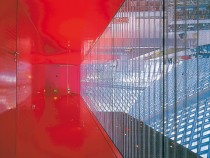
© Christian Richters
In the course of history, the spatial configuration of libraries has changed many times and may be seen to reflect the rise and fall of cultural and political hierarchies. The actual modus operandi of the library has, nevertheless, remained essentially the same. Libraries are places where knowledge is stored, ordered, preserved and passed on. Information today is produced in order to be sold. Conversely, it is consumed in order to be turned to account in new production. As a?result, the?increasingly commodity-like nature of knowledge has an effect on our perception of?the public realm and must ultimately imperil the existence of the library as a?public institution. Computers and the spread of online services are not only modifying our relations to the territory (by overcoming the reality of distance); they are also changing our definitions of “private” and “public”. Increasingly controlled by commercial interests, the World Wide Web provides the user with a holistic environment in which information is combined with entertainment and where data are assimilated into a comprehensive experience through the superimposition of images, sound and text. (Anna Klingmann)






